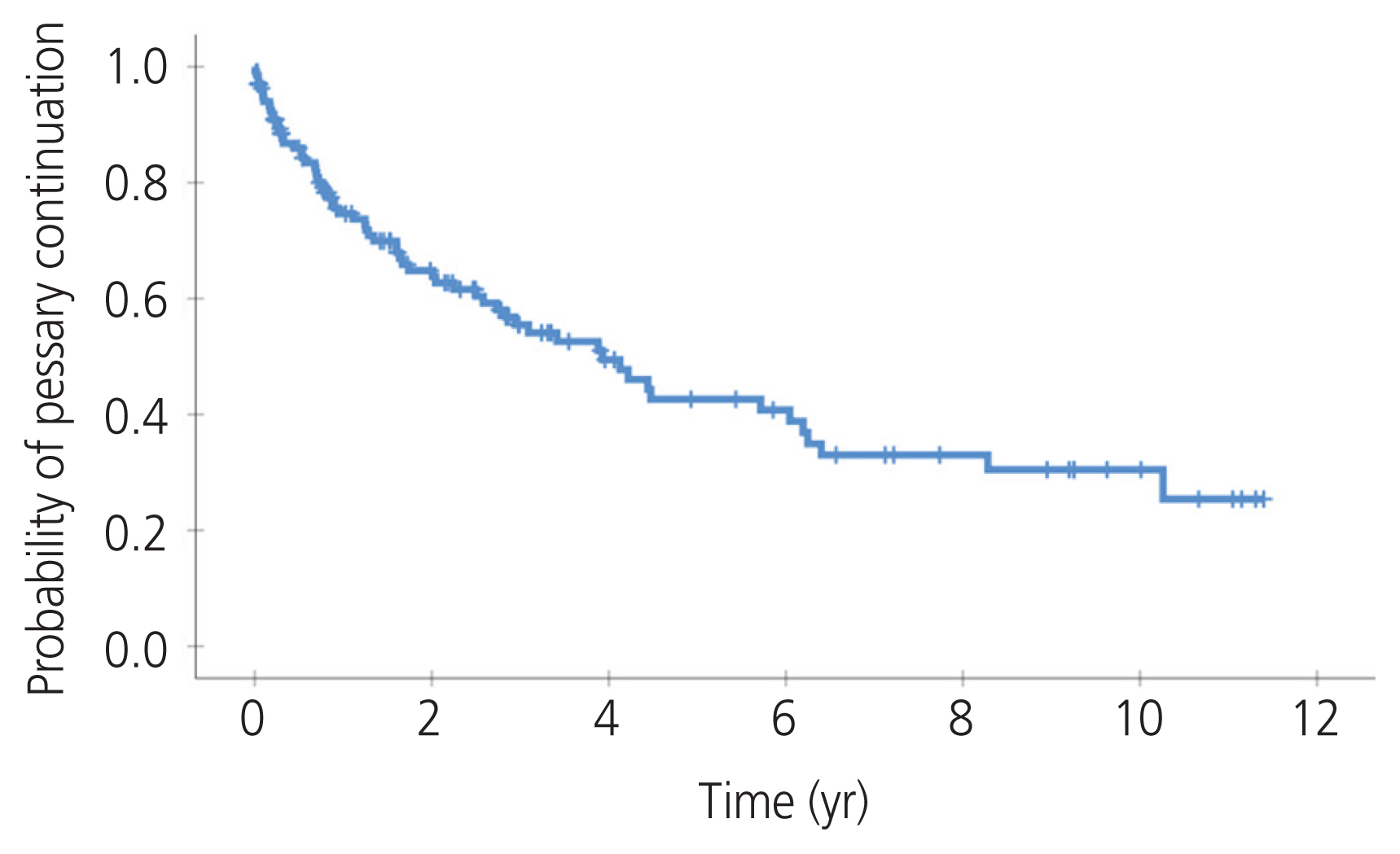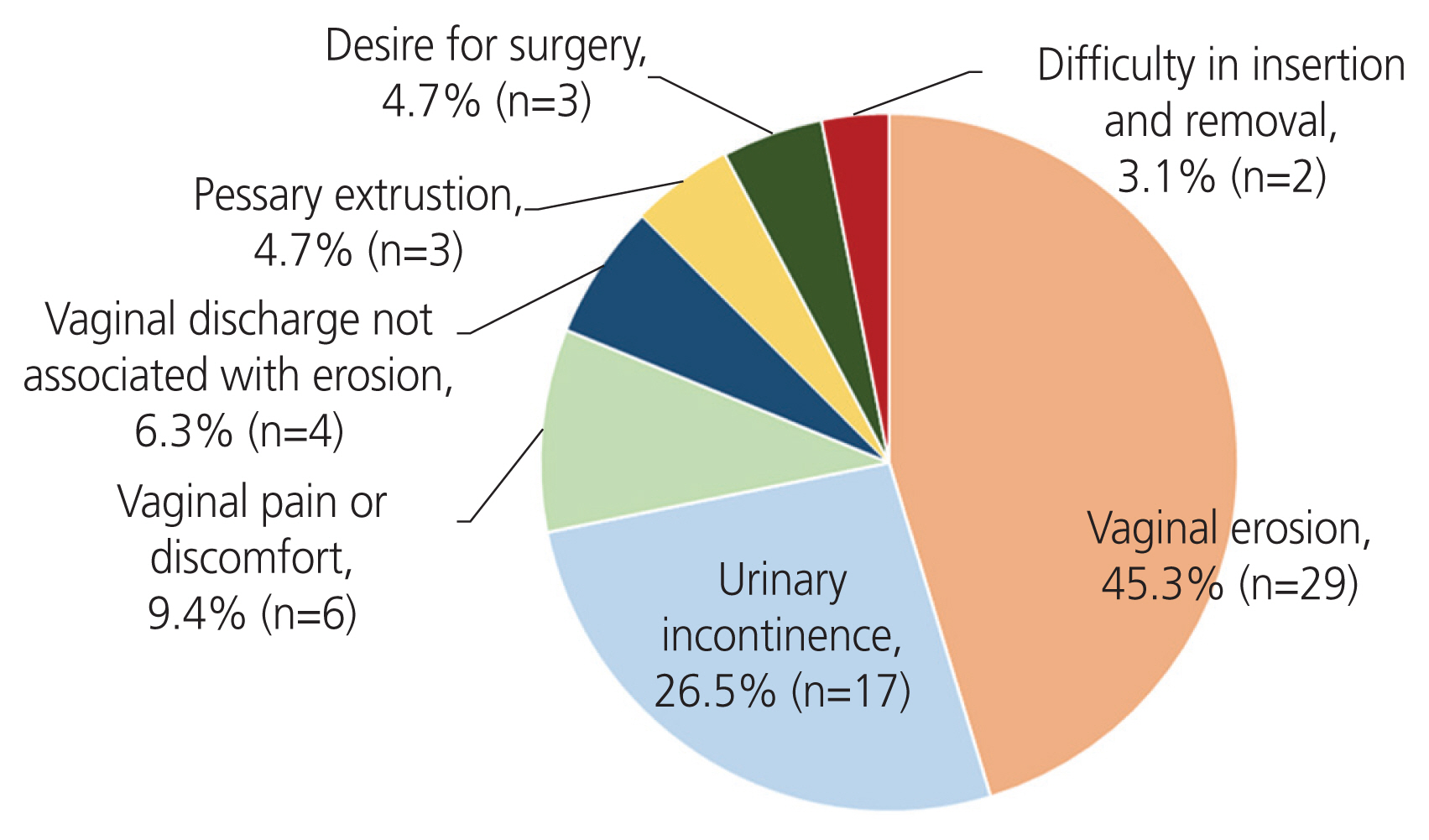Obstet Gynecol Sci.
2022 Jan;65(1):94-99. 10.5468/ogs.21232.
Factors associated with unsuccessful pessary fitting and reasons for discontinuation in Korean women with pelvic organ prolapse
- Affiliations
-
- 1Department of Obstetrics and Gynecology, Seoul National University Hospital, Seoul, Korea
- 2Department of Obstetrics and Gynecology, Seoul National University College of Medicine, Seoul, Korea
- KMID: 2524689
- DOI: http://doi.org/10.5468/ogs.21232
Abstract
Objective
To identify the factors associated with unsuccessful pessary fitting and reasons for pessary discontinuation in Korean women with pelvic organ prolapse (POP).
Methods
The medical records of 234 patients who underwent pessary fitting for the management of symptomatic POP were retrospectively reviewed. A ring pessary with or without support was used. Successful pessary fitting was defined as the ability to wear a pessary for 2 weeks without any discomfort. Factors associated with unsuccessful pessary fitting were determined using a multivariable logistic regression analysis. A Kaplan-Meier survival curve was obtained to examine the probability of continuing pessary use over the follow-up period. The reasons for the discontinuation of pessary were identified.
Results
Two-hundred-and-twenty-five women were included in the analysis. The rate of unsuccessful pessary fitting was 40%. Prior hysterectomy (odds ratio [OR], 4.13; 95% confidence interval [CI], 1.81-9.42) and POP quantification stage III-IV (OR, 2.49; 95% CI, 1.28-4.85) were independent risk factors for unsuccessful pessary fitting. Among the patients with successful pessary fitting, the median time to discontinuation of pessary use was 4 years. The most common causes of discontinued use were vaginal erosion (45.3%) and urinary incontinence (26.5%).
Conclusion
Patients with a history of hysterectomy and advanced-stage POP are at risk for an unsuccessful fitting of the ring pessary. Vaginal erosion is the main reason for discontinued use among patients with successful pessary fitting.
Keyword
Figure
Reference
-
References
1. Hagen S, Stark D. Conservative prevention and management of pelvic organ prolapse in women. Cochrane Database Syst Rev. 2011; (12):CD003882.
Article2. Nygaard I, Barber MD, Burgio KL, Kenton K, Meikle S, Schaffer J, et al. Prevalence of symptomatic pelvic floor disorders in US women. JAMA. 2008; 300:1311–6.
Article3. Lone F, Thakar R, Sultan AH. One-year prospective comparison of vaginal pessaries and surgery for pelvic organ prolapse using the validated ICIQ-VS and ICIQ-UI (SF) questionnaires. Int Urogynecol J. 2015; 26:1305–12.
Article4. Sung VW, Wohlrab KJ, Madsen A, Raker C. Patient-reported goal attainment and comprehensive functioning outcomes after surgery compared with pessary for pelvic organ prolapse. Am J Obstet Gynecol. 2016; 215:659e1–7.5. Bai SW, Yoon BS, Kwon JY, Shin JS, Kim SK, Park KH. Survey of the characteristics and satisfaction degree of the patients using a pessary. Int Urogynecol J Pelvic Floor Dysfunct. 2005; 16:182–6. discussion 186.
Article6. Cundiff GW, Weidner AC, Visco AG, Bump RC, Addison WA. A survey of pessary use by members of the American Urogynecologic Society. Obstet Gynecol. 2000; 95(6 Pt 1):931–5.
Article7. Yuk JS, Lee JH, Hur JY, Shin JH. The prevalence and treatment pattern of clinically diagnosed pelvic organ prolapse: a Korean National Health Insurance Database-based cross-sectional study 2009–2015. Sci Rep. 2018; 8:1334.
Article8. Panman CM, Wiegersma M, Kollen BJ, Burger H, Berger MY, Dekker JH. Predictors of unsuccessful pessary fitting in women with prolapse: a cross-sectional study in general practice. Int Urogynecol J. 2017; 28:307–13.
Article9. Fernando RJ, Thakar R, Sultan AH, Shah SM, Jones PW. Effect of vaginal pessaries on symptoms associated with pelvic organ prolapse. Obstet Gynecol. 2006; 108:93–9.
Article10. Mao M, Ai F, Zhang Y, Kang J, Liang S, Xu T, et al. Predictors for unsuccessful pessary fitting in women with symptomatic pelvic organ prolapse: a prospective study. BJOG. 2018; 125:1434–40.
Article11. Mutone MF, Terry C, Hale DS, Benson JT. Factors which influence the short-term success of pessary management of pelvic organ prolapse. Am J Obstet Gynecol. 2005; 193:89–94.
Article12. Ma C, Xu T, Kang J, Zhang Y, Ma Y, Liang S, et al. Factors associated with pessary fitting in women with symptomatic pelvic organ prolapse: a large prospective cohort study. Neurourol Urodyn. 2020; 39:2238–45.
Article13. Markle D, Skoczylas L, Goldsmith C, Noblett K. Patient characteristics associated with a successful pessary fitting. Female Pelvic Med Reconstr Surg. 2011; 17:249–52.
Article14. Clemons JL, Aguilar VC, Tillinghast TA, Jackson ND, Myers DL. Risk factors associated with an unsuccessful pessary fitting trial in women with pelvic organ prolapse. Am J Obstet Gynecol. 2004; 190:345–50.
Article15. Lamers BH, Broekman BM, Milani AL. Pessary treatment for pelvic organ prolapse and health-related quality of life: a review. Int Urogynecol J. 2011; 22:637–44.
Article16. Bump RC, Mattiasson A, Bø K, Brubaker LP, DeLancey JO, Klarskov P, et al. The standardization of terminology of female pelvic organ prolapse and pelvic floor dysfunction. Am J Obstet Gynecol. 1996; 175:10–7.
Article17. Culligan PJ. Nonsurgical management of pelvic organ prolapse. Obstet Gynecol. 2012; 119:852–60.
Article18. Ding J, Song XC, Deng M, Zhu L. Which factors should be considered in choosing pessary type and size for pelvic organ prolapse patients in a fitting trial? Int Urogynecol J. 2016; 27:1867–71.
Article19. Broens-Oostveen MC, Mom RM, Lagro-Janssen AL. Genital prolapse; treatment and course in four general practices. Ned Tijdschr Geneeskd. 2004; 148:1444–8.20. Sarma S, Ying T, Moore KH. Long-term vaginal ring pessary use: discontinuation rates and adverse events. BJOG. 2009; 116:1715–21.
Article21. Lone F, Thakar R, Sultan AH, Karamalis G. A 5-year prospective study of vaginal pessary use for pelvic organ prolapse. Int J Gynaecol Obstet. 2011; 114:56–9.
Article22. Abdulaziz M, Stothers L, Lazare D, Macnab A. An integrative review and severity classification of complications related to pessary use in the treatment of female pelvic organ prolapse. Can Urol Assoc J. 2015; 9:E400–6.
Article
- Full Text Links
- Actions
-
Cited
- CITED
-
- Close
- Share
- Similar articles
-
- Clinical study of the use of silicone ring pessary in management of pelvic organ prolapse
- The Use of Silicone Ring Pessary in Management of Pelvic Organ Prolapse of Korean Women
- Diagnosis and treatment of Pelvic Organ Prolapse
- Comparison of outcomes between pessary use and surgery for symptomatic pelvic organ prolapse: A prospective self-controlled study
- Surgical treatments for vaginal apical prolapse



